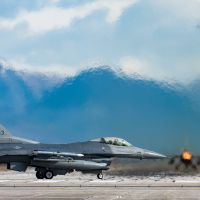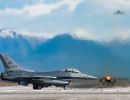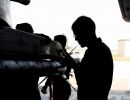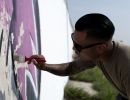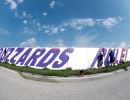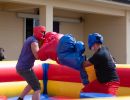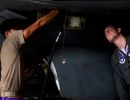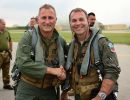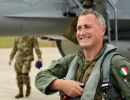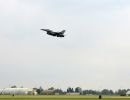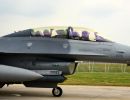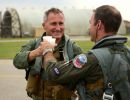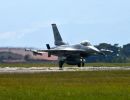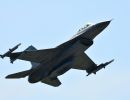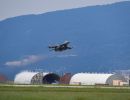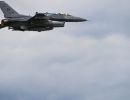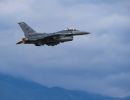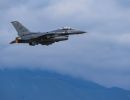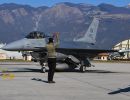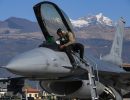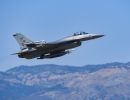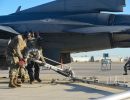On December 7, 1941, the 20th Pursuit Group had just returned to Hamilton Field from Carolina maneuvers. After a few weeks of "defending" San Francisco, the squadrons were dispersed. Col. James Ferguson’s squadron moved to Wilmington, NC and later Myrtle Beach, where fighter training was initiated to meet the replacement needs and rapid expansion of new units.
In the fall of 1942, the Squadron moved to Tampa (flying P-40’s, P-36’s and P-43,s) and organized the 337th Fighter Group. In January, 1943, Col. Ferguson moved the Group Headquarters and two squadrons to Sarasota, Florida, with two Squadrons based at Pinellas (near St. Petersburg). With each move, cadres of officers and enlisted men were lost to newly formed groups—one officer and 40 men were the basis for each new squadron.
Third Fighter Command, in November, 1943, formed the 405th Fighter/Bomber Group with Jim Ferguson in command and Bob Delashaw as deputy. They moved up from Sarasota to Walterboro, South Carolina where the new unit was to be based for training in P-39’s. Pilots began arriving to join the squadron with flight commanders and ground personnel already in place. All were young men—a couple had not yet had to shave and some hadn’t learned to drive a car. The P-39’s were shortly replaced with new P-47 Thunderbolts. After five months of intensive training, the three squadrons (509th, 510th and 5llth) were considered ready for combat.
Bob Delashaw, on February 15, 1944, took a cadre from Charleston, South Carolina to England. About a week later Jim Ferguson led the rest of the Group to Camp Shanks, New York. Following processing, the 405th joined a light bomber group and several support units aboard the Cunard Liner Mauretania—which had just completed her maiden voyage. A few hours out of harbor, the Mauretania ran through the escort formation and, zigzagging at flank speed, proceeded unescorted across the Atlantic. She made landfall at Liverpool in less than five days.
To the applause of locals, the 405th marched through Liverpool (in full uniform) to entrain for Christchurch on the south coast of England. Their new "airstrip" was a small, undulating pasture adjoining a factory. General Pete Quesada ordered an engineering battalion to fill in the valleys, lengthen the field and the Group was ready for the arrival of its new P-47’s. While the aircraft were being de-pickled the Squadrons flew orientation flights while Ferguson flew six combat missions to Belgium and Holland with 8th Fighter Command.
About March 15, 1944 the 405th went operational, flying escort, conducting fighter sweeps and attacking marshaling yards (concentrating on curved RR tracks which made repair difficult).
As plans for D-Day in Normandy developed, Jim Ferguson was assigned to 9th Fighter Command as a U.S. Operations Officer at Oxbridge, later to be control center for the invasion. Bob Delashaw took command of the 405th.
On D-Day, Ferguson was on duty in the "hold" as the armada crossed the Channel to Normandy beaches. The 405th protected the right flank of the invading force. Between midnight and 2 A.M. the air Armada started across--400 heavy bombers, 350 medium bombers and 400 plus transports and gliders. At his controller job, Ferguson glanced back to see General Eisenhower and Prime Minister Churchill looking over his shoulder.
As soon as enough ground had been secured, following the Normandy invasion, airbases were built on the continent. On July 12, 1944, Bob Delashaw moved the three squadrons across the Channel to Picauville, near St. Mere Eglise on the Cherbourg Peninsula. The strip was bulldozed out of an apple orchard, had a 3,800 foot tarpaper covered runway, and was shared with a Mosquito equipped night fighter outfit. Lifting a P-47, with an overload of ammunition and two 1,000 pound bombs off that short runway was exciting.
As General Patton’s Third Army moved east across France, advanced bases were prepared. The 405th skipped the one assigned at Creteville (A-6k) and set up operations at St. Dizier, about 120 miles east of Paris.
The 405th was transferred to the XIX Tactical Air Command on October 19th, 1944, but continued flying close support to the Third Army.
Still following the front line advance, the unit moved in February, 1945 to Belgium. The base was designated Y-32 and was near the town of Zwartburg near- Liege. Now assigned to XXIX TAC, the unit flew support to the IX Army for the crossing on the Rhine River into Germany.
On May 1, 1945 the three squadron’s occupied its last combat base at Kitzengen, Germany (R-6). Shortly thereafter, on May 8, all three 405th squadrons participated in a victory flyover.
One of the finest fighter squadrons of WWII had completed its mission. The 510th squadron had done its job with honor and compiled one of the European Theatre’s most impressive records.
Claimed Destruction of the Following:
| E/A In Air | 39 | Engines, Locomotives | 445 |
| E/A On Ground | 68 | Freight Cars | 1637 |
| Tanks | 119 | Motor Transports | 2418 |
| Staff Cars | 198 | Bridges | 12 |
| Gun Emplacements | 264 | Buildings, Factories | 449 |
| Radar Stations | 6 | Horses, Cows, Livestock | 2709 |


